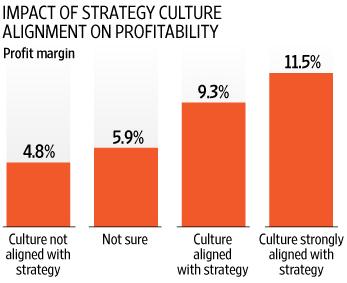And the answer is a firm yes! Have you ever noticed? Watching a soccer game is almost similar to a well-choreographed dance performance – every step/movement has a specific purpose that each artist/player knows very well. In other words, the game or the dance performance is one of the finest examples of PERFECT TEAM ALIGNMENT. The same goes for employees and their employers. But, the organization alignment doesn’t come easily — it takes proper communication, an intelligent planning and a great deal of hard work.
Findings of Tata Strategic Management Group Report
The Strategy-Culture Alignment study report, published by Tata Strategic Management Group, discovered that companies, with a well-organized strategy-culture arrangement, report 5 percent more PROFITABILITY. According to the report more than half the number of surveyed companies in India, with the turnover exceeding $100 Million, admitted that their existing culture was not something they had imagined as business leaders. Some other key highlights of the report:
- – All respondents acknowledged that business strategy aligned with organizational culture increase business profitability.
- – 87% of respondents (industry leaders) admitted that in future they will align their organizational culture with their evolving business plans.
- – While 69% of the survey respondents voted that their organizational culture is already aligned to their business strategy.
- – The majority of respondents believe that “the intangible nature of organizational culture” is the key reason behind the lack of organizational alignment.
- – The report also reveals that the most prominent culture in Indian organization is the “Clan Culture”.
- – And, the supremacy of the “Clan Culture” declines with the surge in the turnover of the company.

 |  |
The report captured insights from CEOs, CXOs and subject-matter experts on culture trends across industries in India. It is based-on the Organizational Culture Assessment Instrument (OCAI) tool.
Decisive Factors of Organizational Alignment
Vision and Mission Statements
According to experienced HR professionals, these statements explain the ultimate goal and the plan to achieve the same in your organization. Therefore, these are very important decisive factors. If your organization does not have vision or mission statement, it may split focus in different directions.
Long and Short-Term Planning
Most of the time, long-term planning refers to strategic planning. It outlines your organization’s business strategy and long-term goals. On the other hand, short-term planning refers to the operational as well as business plan. It outlines annual or half yearly or quarterly goals.
Cascading
While most organizations (of a reasonable size) do plan their short-term and long-term goals, they often forget to communicate these to non-management employees. Ideally, the goals should be broken down by SBUs, departments, teams and so on and each employee should be expected to be a key contributor to these.
Performance Appraisal System
With a well-structured performance appraisal system, HR department can convey a message that every individual’s contribution has been measured and acknowledged in a transparent manner. This system also lets the workforce know how well it is doing, or where perfection is required, which is an important step in reducing employer’s liability.
Collaborative Approach
If not highly formalized, it should at least be effective to ensure the uninterrupted flow of information/communication within the organization. According to experts, without a smooth communication system, there is a little scope for business success. Therefore, it is important for management and CEOs to conduct town halls and floor meetings at least once every quarter.
Author’s Take
HR departments should take the responsibility for organizational alignment through a number of tools that are available to them. This way they would be able to add tremendous value to their organizations and their employees.



